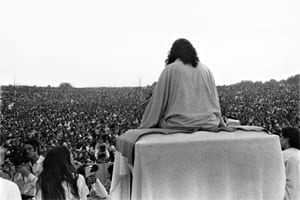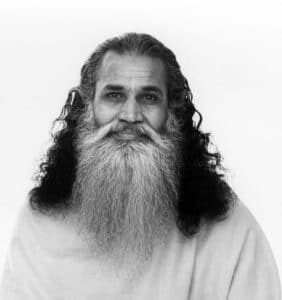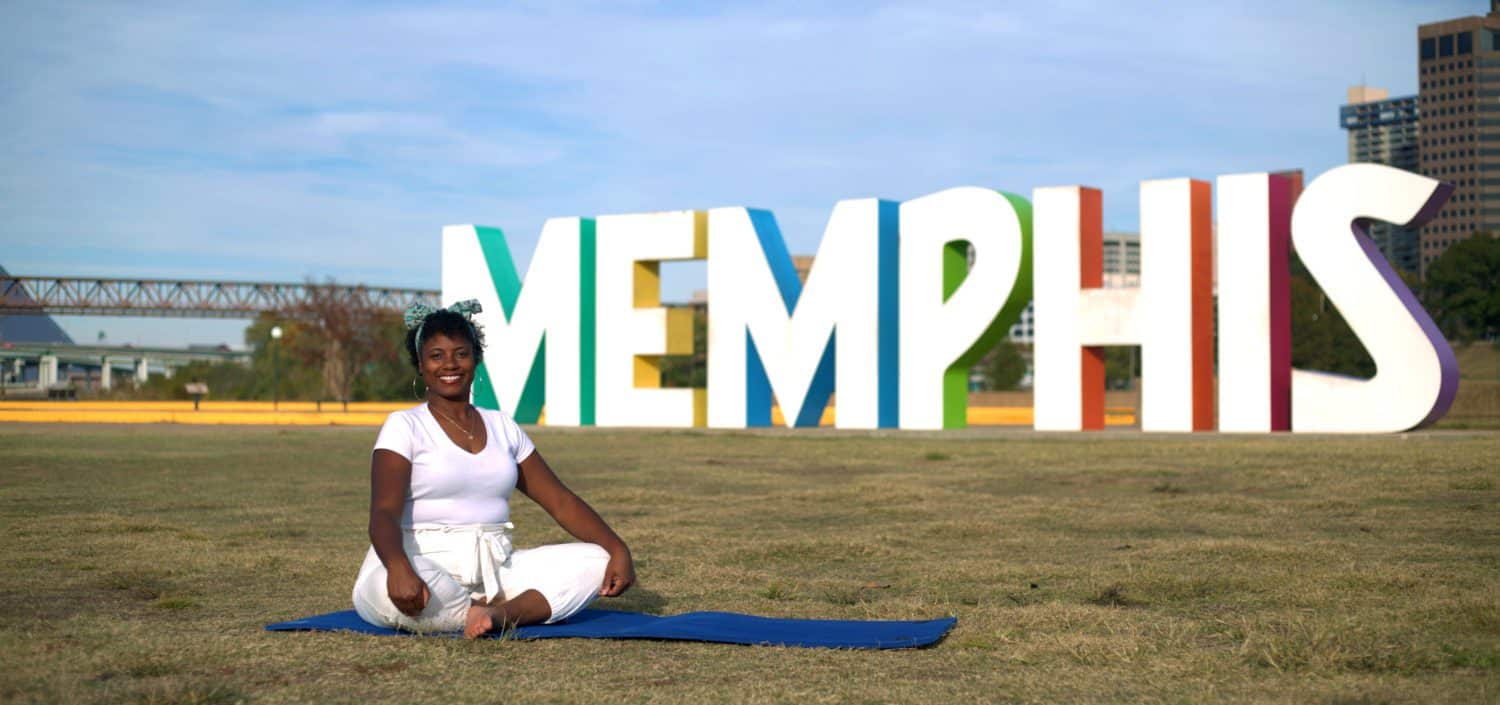An Interview with Swami Asokananda
Originally published in Namaste (The New York IYI Teachers Newsletter), October, 2012.
Namaste: How did you first come into contact with Gurudev?

Swami Satchidananda opening Woodstock in 1969.
Swami Asokananda: Well, the first time I saw Swami Satchidananda—though I don’t know if I’d call it “contact”—was at the Woodstock Music Festival in 1969. At the time, I had no idea that I had just met my Guru.
After high school, something was awakening from deep inside me. I had no religious background growing up, so it caught me by surprise. Like many young folks in the late ‘60s and early ‘70s, my reality was being shaken up by psychedelic drugs. It awoke a deep probing and questioning about what was important in life, which drove me toward spirituality.
I went to college in Binghamton, NY, and started hitchhiking 5-6 hours to New York City on weekends to take Yoga classes. I had just looked in the Yellow pages—at the time there weren’t that many places teaching Yoga (laughs). Integral Yoga was listed there and I was guided to my spiritual home.
Namaste: What year was it?
Swami Asokananda: Probably 1970. I started going to Swami Satchidananda’s lectures on Friday nights at the Universalist Church. On Saturday I would go to IYI on West End Avenue and take a Hatha Yoga class, the Bhagavad Gita class, and then—I was shocked—they invited me to stay for lunch. I saw them as such pure souls. The air at the IYI felt so rarified; I didn’t feel I deserved to even be in their company.
I began to feel that I was not going to get what I was looking for in my life through college. So I dropped out. But the Vietnam War was going on, and if I wasn’t in college, I was going to get drafted. In those days they had the draft. I had a very low draft number, so that meant I was definitely going to war.
So I applied for conscientious objector. I didn’t think I had a leg to stand on—I thought it was mostly for Quakers and Seventh Day Adventists. But, as destiny would have it, my application was approved. However, you don’t get off “scott free.” You have to do two years of alternative service for the welfare of the country. So I asked the IYI administrators if they needed any help, and they said, “Are you kidding? Yoga’s booming! We need plenty help.” I went back to the Military Review Board and told them that I had this option to work for a nonprofit organization—a Yoga center. They approved it!

Swami Satchidananda, lovingly called Gurudev by his disciples.
The IYI folks called Gurudev in Europe while I was in the room and said, “We have this gung-ho guy here named Jeff”—that was me—“We’re going to send him to Washington D.C.” There was a pause on the phone, then Gurudev answered, “No, send that fellow”—I didn’t think he knew who I was—“to Hartford, Connecticut.”
The beauty of that was that shortly after that, Gurudev moved from New York to Danbury, Connecticut. And I was at the closest IYI to him. So, he would sometimes call and say, “Do you want to bring some people down and do some landscaping around the house?” Of course, I’d go “Yeah, Gurudev, we want to come.” He’d say, “Okay, but you’re coming to work; don’t plan on seeing me.” “Yes, Gurudev, we know, we’re coming to work.” But he would always work with us, bring us tea and cookies, and sit down with us at the end of the day. So in those formative years of my spiritual upbringing, I had a chance to see up close and personal what an enlightened person is like. If I had been sent to Washington as planned, I would have missed out on this early education.
I was living in the Connecticut IYI as a “whole-time member,” meaning I was serving at the center full-time, getting immersed in the yogic lifestyle. I was reading the Gospel of Sri Ramakrishna, by a man who simply called himself “M.” It talked about the importance of receiving a mantra from an enlightened being. This made a deep impression on me, so I wrote to Swami Satchidananda and said, “I’d like to receive a mantra from you. I understand that this would really benefit me. But I don’t know if you’re my Guru. I’m not sure how that works. They say if the disciple is ready, the Guru appears. I don’t want to force anything. Are you appearing or am I am prematurely pushing this?”
I got a message to call him, which spooked me out because I never spoke to him before. When I called, he said that he appreciated my asking these questions. Many people take mantra initiation without considering the Guru-disciple relationship. They just take the mantra and run.
And then he said something that has impacted to this day. He said, “The mind has no light of its own. It’s just a reflected light, like the moon. Though the moon may seem like the brightest body in the night sky, it actually has no light. The mind is the same way; it has a reflected light, received from another Source. There are certain key decisions in one’s life that should not be make through the reflection (the mind), but from the Source (the Atman). Mantra initiation and determining your Satguru is one of them.”
Namaste: That’s beautiful.
>Swami Asokananda: He said “When the Inner Sun guides you, you won’t have any doubt. That’ll be the sign. You’ll know what to do.” About a half a year passed, and I got the clear message he was talking about. It was like he said, I knew without a doubt that he was my Guru. But I had to wait about another half a year for the initiation to take place. It was about a year from that phone call, and I was really hungry for it.
But during that year, I developed a very intimate connection with the mantra “Hari Om.” I was concerned if I could really let go of “Hari Om,” which had been serving me so well. But when Gurudev gave me the mantra—he touched me on the head as he gave the mantra—I literally “saw” Hari Om merging with my new mantra. Hari Om was letting me know that all that I had invested in it was going to be transferred to my “new account.”
Namaste: Wow, it sounds like everything happened in a flow, all the things that needed to happen in your life, and the expediencies—and one thing led to the other.

Swami Asokananda leads a teacher training at Yogaville in 2016.
Swami Asokananda: My experience has been like that. When I was young on the path, Gurudev was always there, guiding me and bringing me what I needed. As I matured, he pulled back and expected me to figure things out more. He was no longer going to just put things in my lap. The way he related to me was more like: “Okay, I more directly supported you in your younger years. Now you have to make conscious choices about what you really want with your life. I’m still here—I’ve got your back—but it is time for you to take the reins more.
Namaste: Sounds like a really good father.
Swami Asokananda: When you mature, what is it they say? “With great power comes great responsibility.” As we unfold as yogis, we have more responsibility to make the right choices, and to be clear: Am I going to lead an egoistic life or lead a life that’s not all about “me”?



